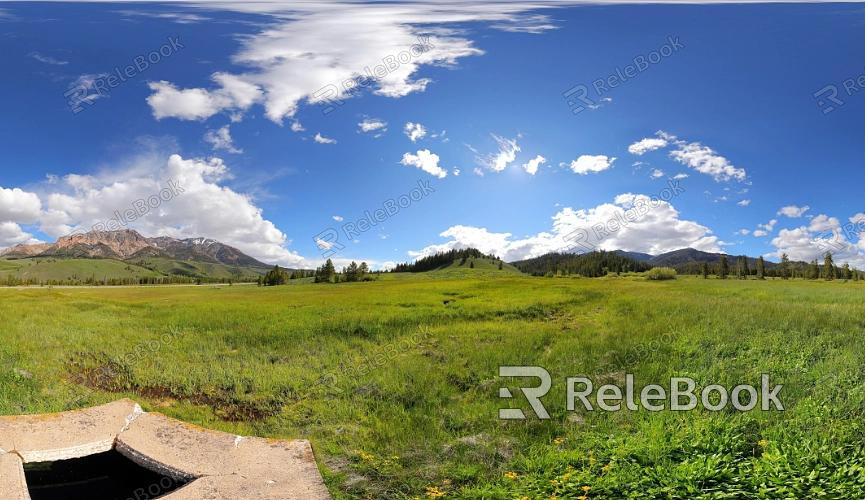What Are the Differences Between HDR and Non-HDR Grass Textures
In creating grass scenes for 3D environments, texture and lighting effects are key factors that significantly impact the realism of the overall scene. The choice between HDR and non-HDR textures directly affects the lighting effects and rendering time. In this article, we’ll explore the differences between HDR grass textures and non-HDR grass textures, helping designers better understand their pros and cons to make the best choice for different projects.

1. Differences in Lighting Information Details
One of the most notable advantages of HDR textures is their ability to store a wider range of lighting information. HDR files can capture not just highlights but also retain rich detail in darker areas, delivering more depth in lighting effects.
Highlight Detail: HDR textures are particularly useful in bright areas, where they can display a greater amount of detail without the risk of overexposure. For grass scenes, this means that even under direct sunlight, the grass will retain its natural texture.
Shadow Retention: Non-HDR textures, by comparison, can lose detail in shadowed areas, leading to muddy or blurred textures. HDR textures, on the other hand, preserve shadow details, boosting the overall realism of the scene.
2. Color Range and Realism
HDR textures are capable of displaying a broader color range than non-HDR textures, which results in a more natural and varied color representation of the grass.
Extended Color Range: HDR grass textures provide a larger color space, allowing designers to capture subtle changes in grass color under different lighting conditions. For instance, grass at sunset with warm hues or cool-toned grass at dawn covered in dew can be more accurately portrayed with HDR textures.
Limitations of Non-HDR: Non-HDR textures tend to have a narrower color range, often appearing flat, especially in high-contrast scenes. As a result, non-HDR grass textures may lack the depth and realism found in more intricate scenes.
3. Rendering Time and Performance Optimization
While HDR textures offer clear visual advantages, they also demand more from rendering performance. HDR files are generally larger than non-HDR files, increasing the complexity of rendering calculations.
Longer HDR Rendering Times: Due to the additional lighting and color information, rendering engines must perform more calculations with HDR textures. In large-scale grass scenes, especially those involving global illumination and complex reflections, this can significantly increase rendering time.
Non-HDR Performance Advantage: Non-HDR textures, being smaller and less complex, are ideal for projects that require quick renders or where fine details aren’t essential. If the grass is part of a distant background or a non-focus area, non-HDR textures can effectively reduce rendering time.
4. Dynamic Range and Flexibility
HDR textures aren’t just limited to static scenes—they’re also ideal for dynamic lighting environments, such as day-to-night transitions or weather changes. Non-HDR textures are more limited in these applications.
Dynamic Lighting Advantage: With HDR grass textures, designers can easily adjust exposure and lighting angles to match changing light conditions. For example, as the intensity of sunlight shifts, HDR grass textures maintain balanced exposure, ensuring a smooth and natural lighting transition.
Limitations of Non-HDR Textures: Non-HDR textures lack the flexibility to adapt to changing lighting conditions, which can result in grass appearing too dark or too bright in dynamic scenes, with less subtlety in light transitions.

5. File Size and Storage Needs
HDR textures are generally much larger than non-HDR textures, which not only impacts rendering speed but also increases the project's storage requirements.
Larger HDR Files: HDR grass textures demand more storage space, especially when high-resolution textures are used. This can consume a significant amount of hard drive space, particularly in large, detailed scenes, requiring designers to balance storage and performance carefully.
Lightweight Non-HDR Files: In contrast, non-HDR textures are smaller in size, reducing the strain on storage. This makes them more suitable for large-scale projects that involve frequent saving, loading, and management of multiple files.
6. Choosing the Right Texture for Your Project
When it comes to actual project application, the decision between HDR and non-HDR grass textures depends on the specific needs of the project. HDR textures are ideal for projects that demand a high level of realism, while non-HDR textures offer a more efficient option for projects that prioritize speed and resource management.
High-Precision Rendering Scenes: If grass is a central visual element in your scene, especially in close-ups or focal points, HDR grass textures can significantly enhance the lighting detail and realism of the environment.
Low-Resource Projects: For simpler scenes or projects with tighter budgets, non-HDR grass textures provide a good balance between maintaining some level of detail and optimizing rendering speed, with lower hardware demands.
In conclusion, understanding the key differences between HDR and non-HDR grass textures in terms of lighting, color range, rendering performance, and file size can help designers make informed decisions for different types of projects. By selecting the right texture type based on the project’s needs, designers can strike the perfect balance between visual quality and performance.
If you're looking for high-quality HDR textures, 3D models, or resources for software like SketchUp or 3ds Max, Relebook offers a wide range of assets to help elevate your designs to the next level.

